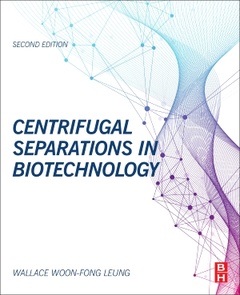Centrifugal Separations in Biotechnology (2nd Ed.)
Auteur : Woon-Fong Leung Wallace

Centrifugal Separations in Biotechnology, Second Edition, is the only book on the market devoted to centrifugal separation in biotechnology. Key topics covered include a full introduction to centrifugation, sedimentation and separation; detailed coverage of centrifuge types, including batch and semi-batch centrifuges, disk-stack and tubular decanter centrifuges; methods for increasing solids concentration; laboratory and pilot testing of centrifuges; selection and sizing centrifuges; scale-up of equipment, performance prediction and analysis of test results using numerical simulation.
Centrifugal Separations in Biotechnology, Second Edition, provides guidance on troubleshooting and optimizing centrifuges, and then goes on to explore the commercial applications of centrifuges in biotechnology. It gives detailed process information and data to assist in the development of particular processes from existing systems. It is of value to professionals in the chemical, bioprocess, and biotech sectors, and all those concerned with bioseparation, bioprocessing, unit-operations and process engineering.
1. Introduction 2. Principles of Centrifugal Sedimentation 3. Batch and Semi-Batch Centrifuges 4. Disk Centrifuge 5. Decanter Centrifuge 6. Commercial Applications of Centrifugation in Biotechnology 7. Concentrating Solids by Centrifugation 8. Lab and Pilot Testing 9. Selection and Sizing of Centrifuges 10. Troubleshooting and Optimization 11. Flow Visualization and Separation Modeling of Tubular Centrifuge 12. Disk Stack Modeling 13. Performance Projection of Centrifuges in Bioseparation 14. Rotating Membrane in Bioseparation
Chemical engineers, process & mechanical engineers, bioengineering professionals, pharmaceutical chemists, process industry R & D experts
Dr. Leung is also a multidisciplinary engineer, scientist, and educator with international academic and industrial experiences. During the COVID-19 pandemic, he has deployed his invented nanofiber technologies in mass production of highly protective, highly breathable facemasks for the public railroad.
- Provides a comprehensive guide to centrifuges, their optimal development, and their operation in the biotechnology industry
- Updated throughout based on developments in industrial applications and advances in our understanding of centrifugal separations in biotechnology
- Discusses applications for the separation of proteins, DNA, mitochondria, ribosomes, lysosomes and other cellular elements
- Includes new sections on use of optimal polymer dosage in waste treatment, new centrifuge designs for applications in algae processing, biopharma, and more
Date de parution : 03-2020
Ouvrage de 502 p.
15x22.8 cm
Thème de Centrifugal Separations in Biotechnology :
Mots-clés :
?Acceleration efficiency; Automatic cake discharge tubular; Baker yeast; Batch and continuous feed; Bimodal size distribution model; Biotechnology/biopharmaceutical flow sheets; Blood; Cake liquid; Cell debris; Cell viability; Cells; Centrate suspended solids; Centrifugal elutriation; Centrifugal filter; Centrifugal filtration; Centrifugation-membrane filtration; Centrifuge; Centrifuge speed; Centripetal pump; Chamber bowl; Chinese hamster ovary cells; Classification/fractionation; Clean-in-place; Clinical manufacturing; Compaction; Concentrate discharge; Concentrate/underflow/cake; Concentration; Coriolis acceleration; Cut size; Decanter; Dewatering; Differential speed; Diffusivity; Disk; Disk stack; Disk-stack centrifuge; Disk-stack model; Drainage kinetics; Dropping bottom; Drug development; Dye and tracer tests; E coli; Enzyme; Experimental verification; External/internal nozzle; Extracellular/intracellular protein; Feed acceleration; Feed rate; Feed size distribution; Filtration Leung number; Floc model; Flocculation; Forward/back-drive; G-area; G-volume; Gel layer control; Gentle acceleration and deceleration; Guide testing; High cake solids; High feed solids; High-mass throughput; Hindered settling; Hormones; In situ floc size; Inclusion body; Insulin; Laboratory; Lamella settler; Le number; Leung number; MAb; Material balance; Max-to-min floc size; Mechanical problem; Membrane filtration; Monitoring; Monodispersed/polydispersed; Monotonic size distribution; Moving layer; Moving layer model; Nonlinear pressure change; Numerical simulation; Omega-3; Operation cycle; Optimization strategy; Osmotic pressure; Particle size distribution; Performance forecast; Performance prediction; Performance projection/forecast; Pilot; Pool depth; Practice; Probiotics; Process objective; Process problem; Production; Protein; Protein yield


